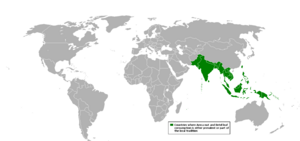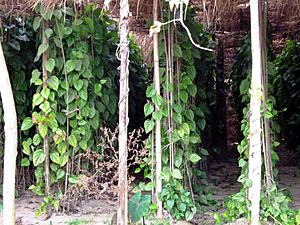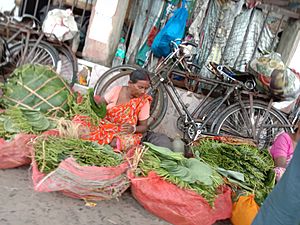Betel facts for kids
Quick facts for kids Betel |
|
|---|---|
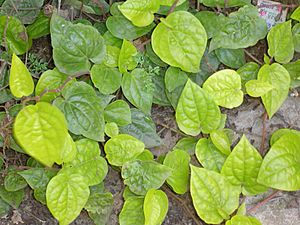 |
|
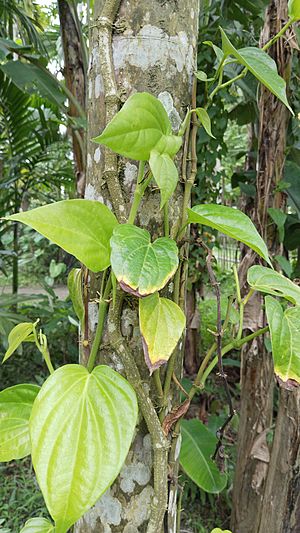 |
|
| Scientific classification | |
| Genus: |
Piper
|
| Species: |
betle
|
The betel (Piper betle) is a type of vine plant. It belongs to the same plant family as pepper and kava. The betel plant originally comes from Southeast Asia.
It is an evergreen plant, meaning its leaves stay green all year. It has shiny, heart-shaped leaves and white flower spikes called catkins. People grow betel plants mainly for their leaves. These leaves are often used for flavoring, especially when chewing areca nut, which is also known as betel nut.
Contents
What's in a Name?
The word "betel" comes from the Malayalam language. The original word was vettila, and it came into English through Portuguese.
Where Betel Grows
Piper betle first grew in South Asia and Southeast Asia. This includes countries like the Philippines, Timor-Leste, Malaysia, Vietnam, Cambodia, Laos, Thailand, and Myanmar.
Over time, people called Austronesians helped spread the plant. They traveled and traded, taking betel to other islands in Southeast Asia. It also spread to Papua New Guinea, Melanesia, Micronesia, and the Maldives. Later, during the time of colonies, it was even brought to the Caribbean.
How Betel is Grown
Betel leaves are mostly grown in South and Southeast Asia. This stretches from Pakistan all the way to Papua New Guinea. The plant is a vine, so it needs something to climb on. Farmers often use a tree or a tall pole for support.
Betel plants need good soil that drains water well and is rich in nutrients. Soils that are too wet, salty, or alkaline are not good for growing betel.
In Bangladesh, farmers who grow betel are called barui. They prepare special gardens called barouj for the plants. These gardens are often fenced with bamboo sticks and coconut leaves.
Farmers dig long, wide, and deep rows in the soil. They mix in things like oil cakes, manure, and leaves with the top layer of soil. They also add wood ash. The young betel plants are put into the ground when the monsoon (rainy) season begins.
It's very important to give betel plants the right amount of shade and water. The soil needs to stay moist, but not too wet. Farmers water the plants often but lightly. Standing water should not stay for more than half an hour.
Farmers add dried leaves and wood ash to the rows every two weeks. They also sprinkle a mix of cow dung and water. Adding different kinds of leaves once a month is thought to help the betel grow well.
In about three to six months, the vines grow quite tall, reaching about 1.5 to 1.8 meters (5 to 6 feet). They will also start to grow branches. Farmers then begin to harvest the leaves. They carefully pick each leaf and its stem with their right thumb. Harvesting usually happens every 15 days to a month.
The harvested betel leaves are used locally in the areas where they are grown. They are also sent to other parts of Asia, the Middle East, Europe, and the Americas. Growing betel is an important way for many people in rural Bangladesh to earn a living.
Economics of Betel
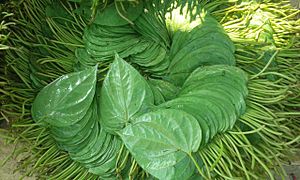
Betel vines are grown across Southeast Asia. The farms are usually small, from about 20 to 2000 square meters (0.005 to 0.5 acres).
In Malaysia, farmers grow four main types of betel plants. After harvesting, the leaves are sold in bundles.
In Sri Lanka, betel grows all over the country. However, the best quality betel, known as “kalu bulath” (dark green, thick leaves), is grown in specific areas. These leaves are sold to wholesalers in large groups of 1000 leaves.
Growing betel can provide extra income for farmers. A successful betel farm can give a farmer work for about six days every six months. The income can be good when the prices for the leaves are high. However, the income from betel farms can change a lot each year. This is because of different rainfall, temperatures, and how many leaves spoil during travel.
In India, betel vines are grown on many farms. This farming supports hundreds of thousands of families who work in agriculture. However, in recent years, the demand for betel leaves has been going down in India. This is partly because people are choosing other chewing products instead of traditional betel leaf preparations. This has led to an oversupply of leaves, making betel farming less profitable for some farmers.
Images for kids
See also
 In Spanish: Betel para niños
In Spanish: Betel para niños


